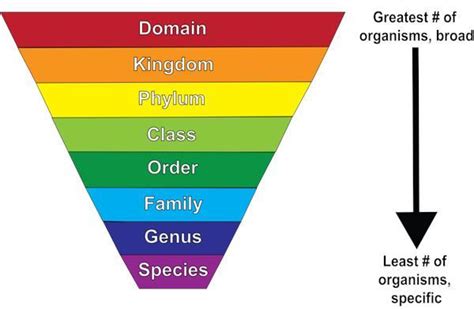Classification levels, from broadest to most specific, are a fundamental concept in various fields, including biology, information science, and data analysis. Understanding these levels is crucial for organizing, categorizing, and analyzing data or objects in a systematic and hierarchical manner. The classification levels, starting from the most general to the most specific, are as follows:
Domain

The domain is the broadest level of classification. It refers to the highest level of grouping in a classification system, encompassing all the lower levels. In the context of biology, for example, the domain is one of the most general ranks used in taxonomy, dividing life into broad categories based on cell type and metabolism. The three main domains in biological classification are Archaea, Bacteria, and Eukarya.
Kingdom
Below the domain level, the next classification level is the kingdom. This level is more specific than the domain and provides a way to categorize organisms based on their cell structure, body organization, and metabolism. In the context of biological classification, the kingdom level comes after the domain and is used to group organisms into categories such as Animalia, Plantae, Fungi, and others.
Phylum (or Division in Plant Classification)

The phylum level (or division in plant classification) is the next level of specificity. It groups organisms based on their body structure and development. In animal classification, phyla are defined by the arrangement of their body parts and the presence of specific features. For plants, the term “division” is used instead of “phylum” but serves a similar purpose, grouping plants based on their evolutionary relationships and morphological characteristics.
Class
The class level is more specific than the phylum/division level. It categorizes organisms based on their morphology and physiology. Classes are often defined by specific characteristics or the absence thereof. For example, in the animal kingdom, Mammalia is a class that includes all mammals, characterized by features such as the presence of hair and the production of milk for their young.
Order
The order level is a further specification, grouping organisms based on their evolutionary relationships and shared characteristics. Orders often reflect common adaptations to the environment or similar body plans. For instance, the order Carnivora includes meat-eating mammals and is characterized by adaptations for a carnivorous diet.
Family
The family level is more specific than the order and groups organisms that share a more recent common ancestor. Families often share similar morphological features and are usually designated by a common suffix (e.g., -idae for animals, -aceae for plants). The family Canidae, for example, includes dogs, wolves, and foxes, all of which share certain physical and behavioral traits.
Genus
The genus level is a classification rank used to group organisms that are closely related and share many physical characteristics. Genera (the plural form of genus) are often defined by a set of specific features and are designated by a single name (in binomial nomenclature, the first part of the species name is the genus). The genus Canis, for instance, includes several species of dogs and wolves.
Species
The most specific level of classification is the species. A species is a group of organisms that can interbreed and produce fertile offspring, and it is the basic unit of biological classification. Species are designated by a binomial name consisting of the genus name followed by a specific epithet (e.g., Canis lupus for the gray wolf). This level represents the most detailed categorization in the hierarchical system of classification.
Key Points
- The classification levels, from broadest to most specific, are domain, kingdom, phylum/division, class, order, family, genus, and species.
- Each level provides a more detailed categorization of organisms based on their characteristics, evolutionary relationships, and body structure.
- The domain is the highest level, dividing life into broad categories, while the species is the most specific, representing the basic unit of biological classification.
- Understanding these classification levels is essential for organizing and analyzing data in biology and other fields.
- The use of binomial nomenclature, such as genus and species names, provides a universal system for identifying and categorizing organisms.
In conclusion, the classification levels from broadest to most specific are fundamental in understanding the diversity of life and organizing information in a systematic way. Each level, from domain to species, provides valuable insights into the characteristics, evolutionary history, and relationships among different organisms, contributing to a deeper understanding of biology and the natural world.
What is the broadest level of classification?
+The domain is the broadest level of classification, dividing life into three main categories: Archaea, Bacteria, and Eukarya.
How are species defined?
+A species is defined as a group of organisms that can interbreed and produce fertile offspring, representing the most specific level of biological classification.
What is the purpose of using classification levels?
+The purpose of using classification levels is to organize and categorize organisms in a systematic and hierarchical manner, providing insights into their characteristics, evolutionary relationships, and body structure.



